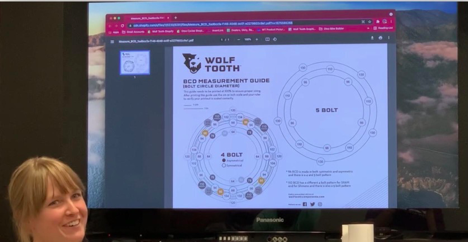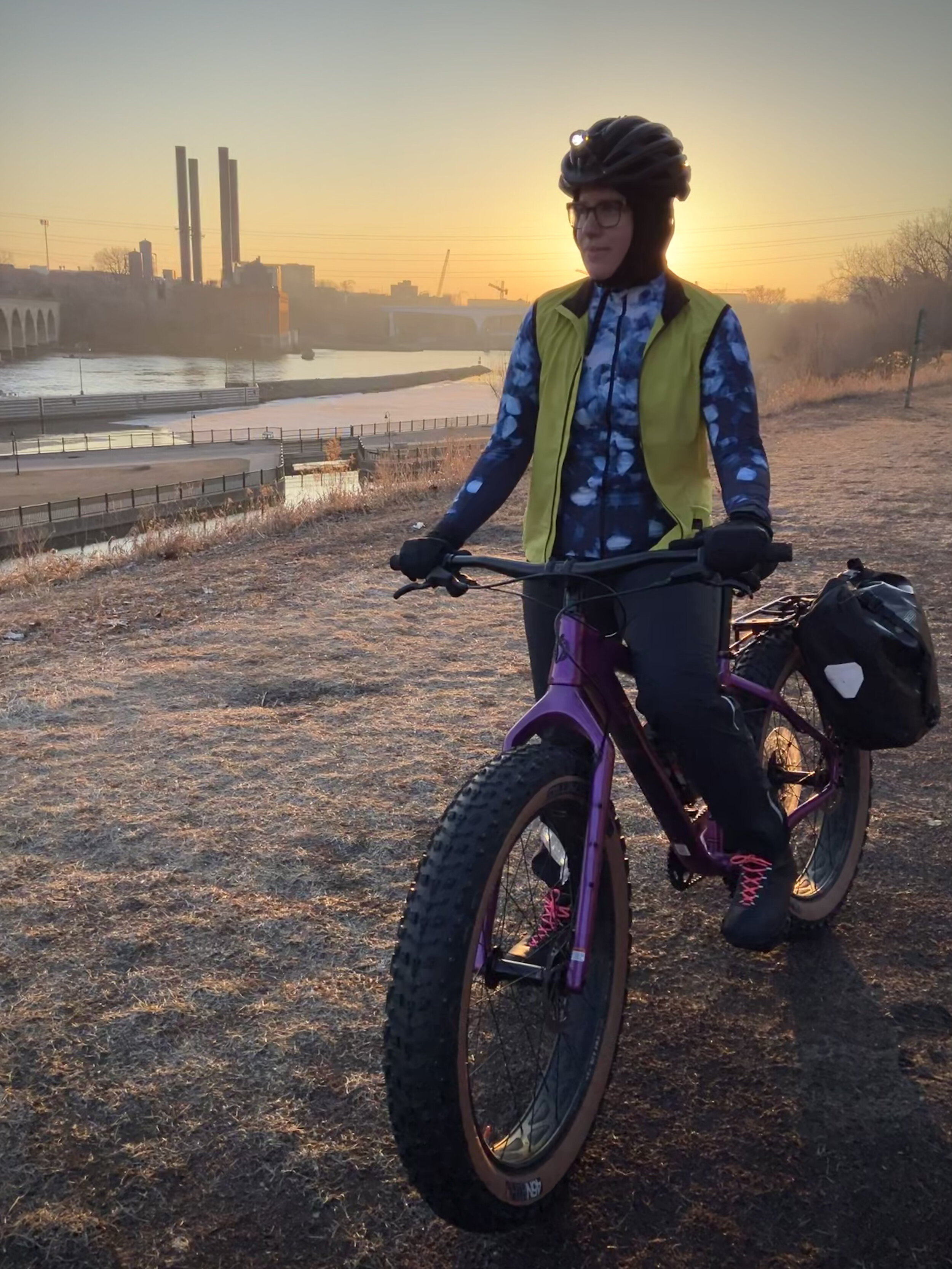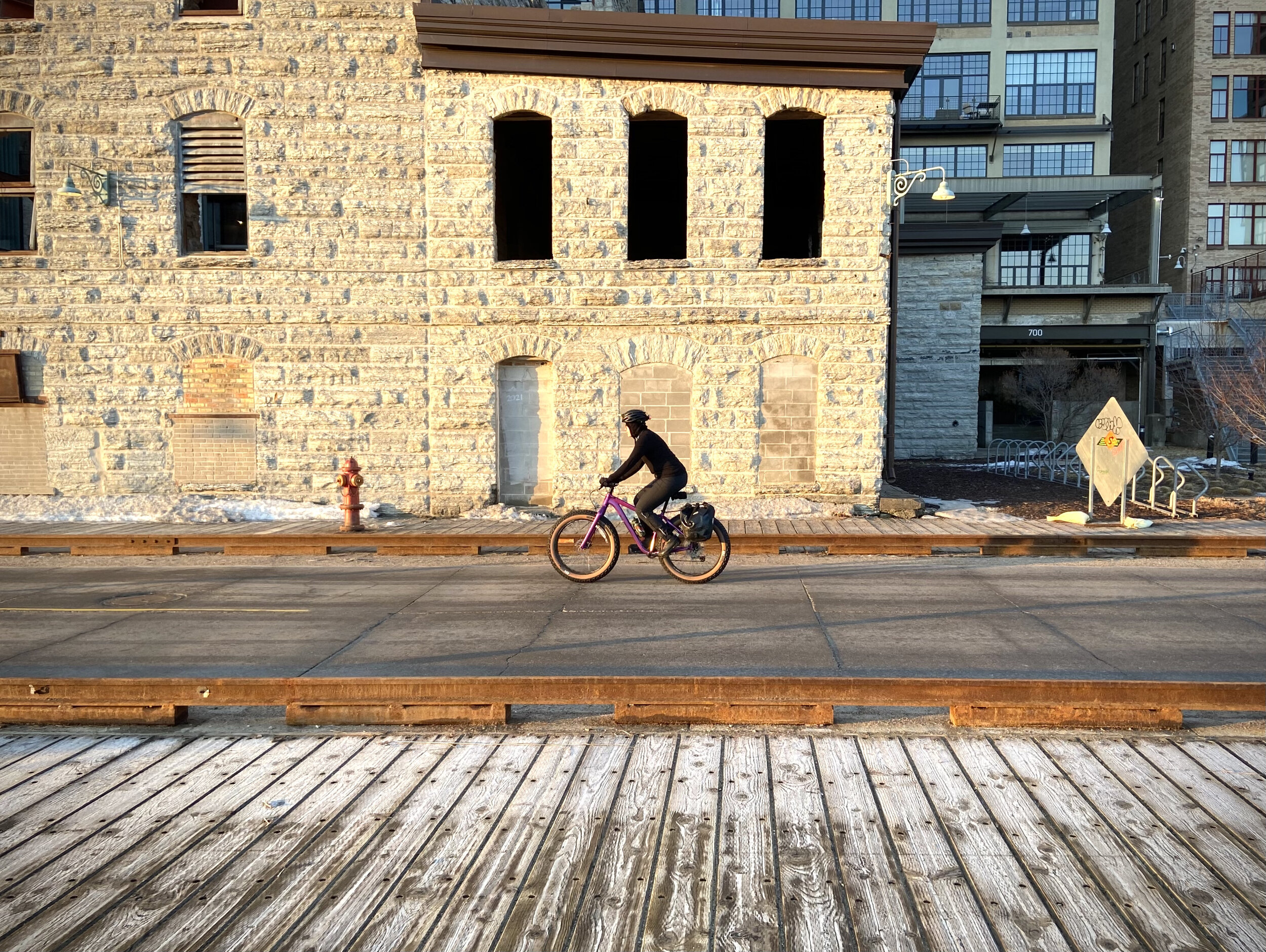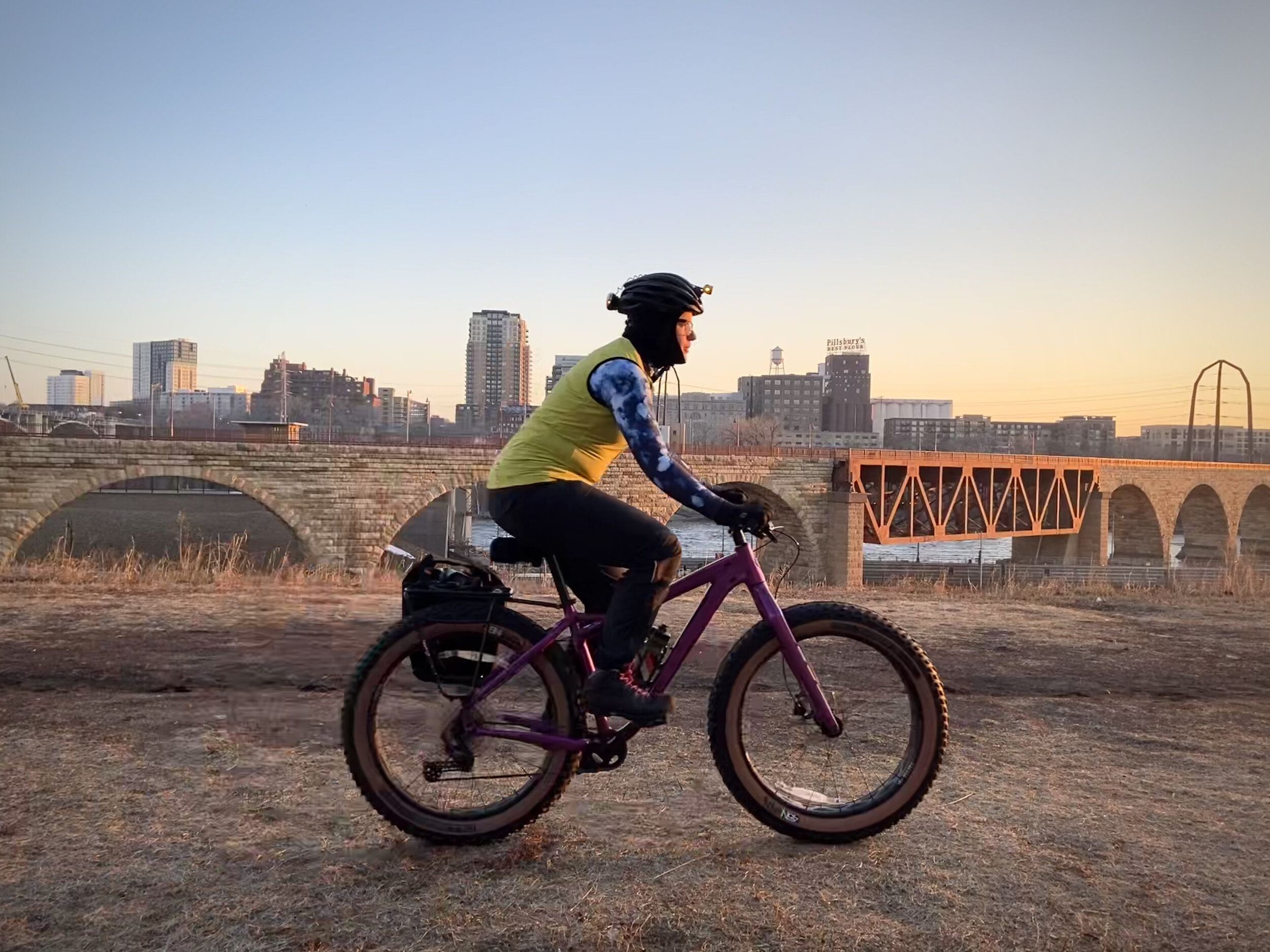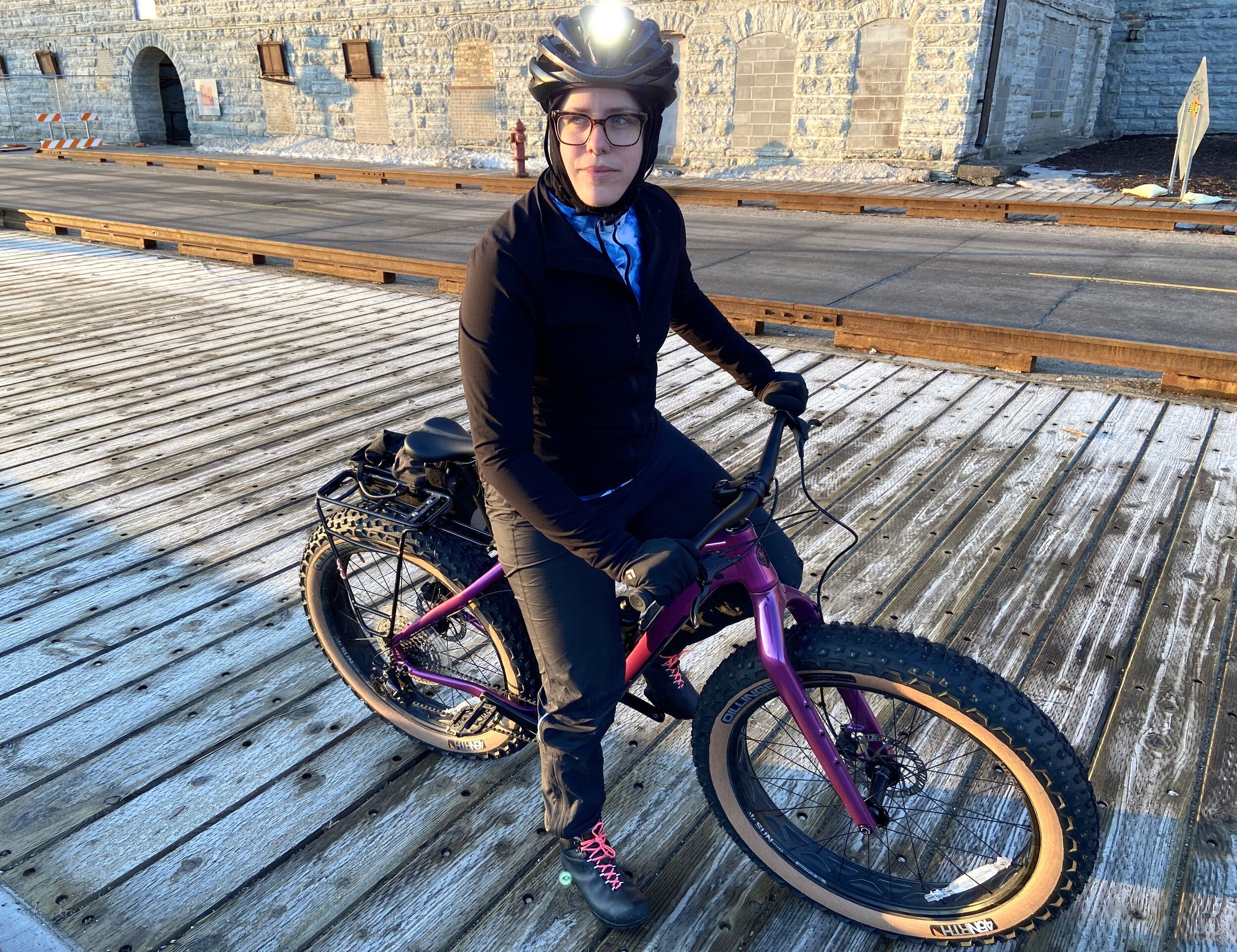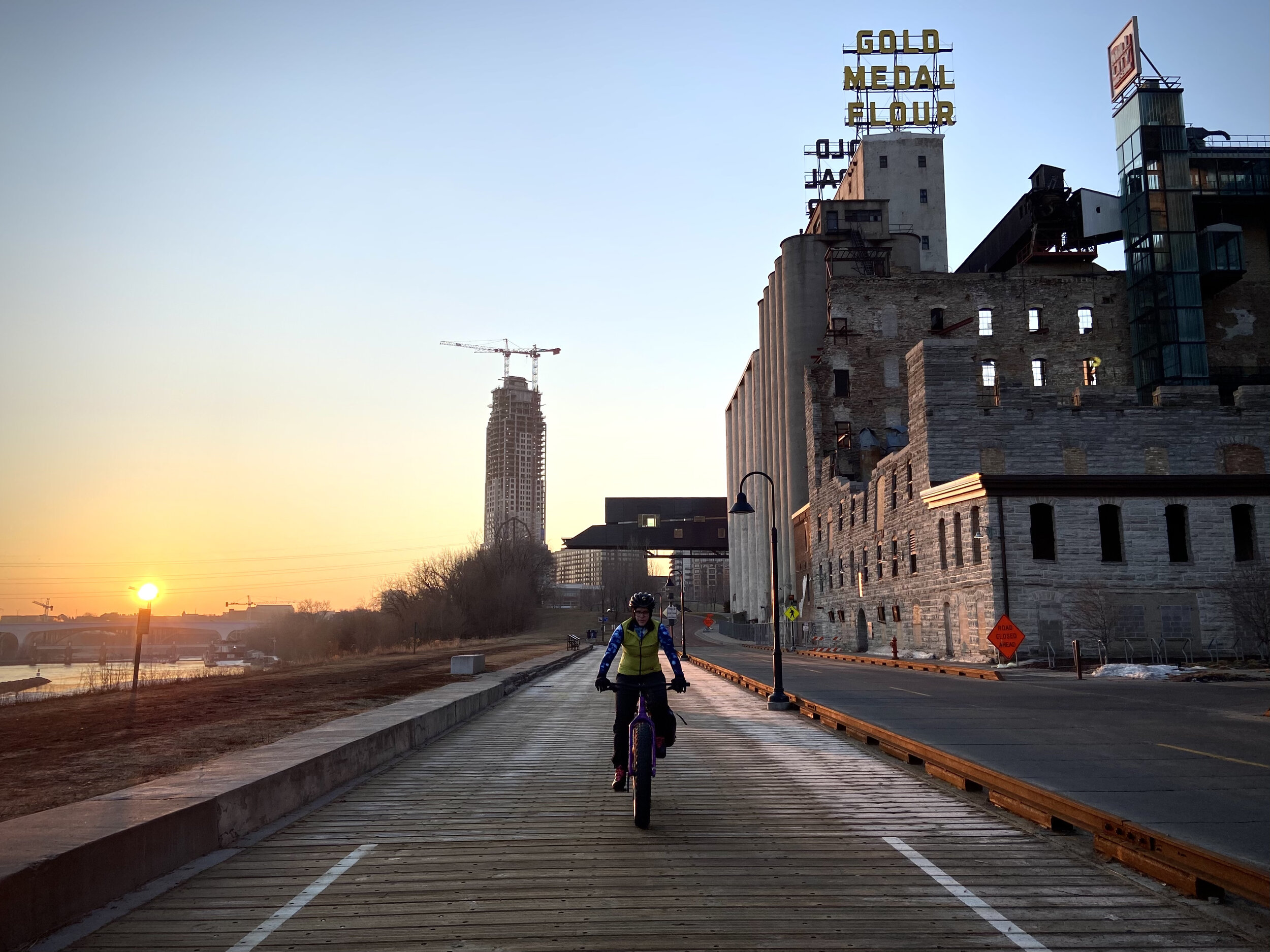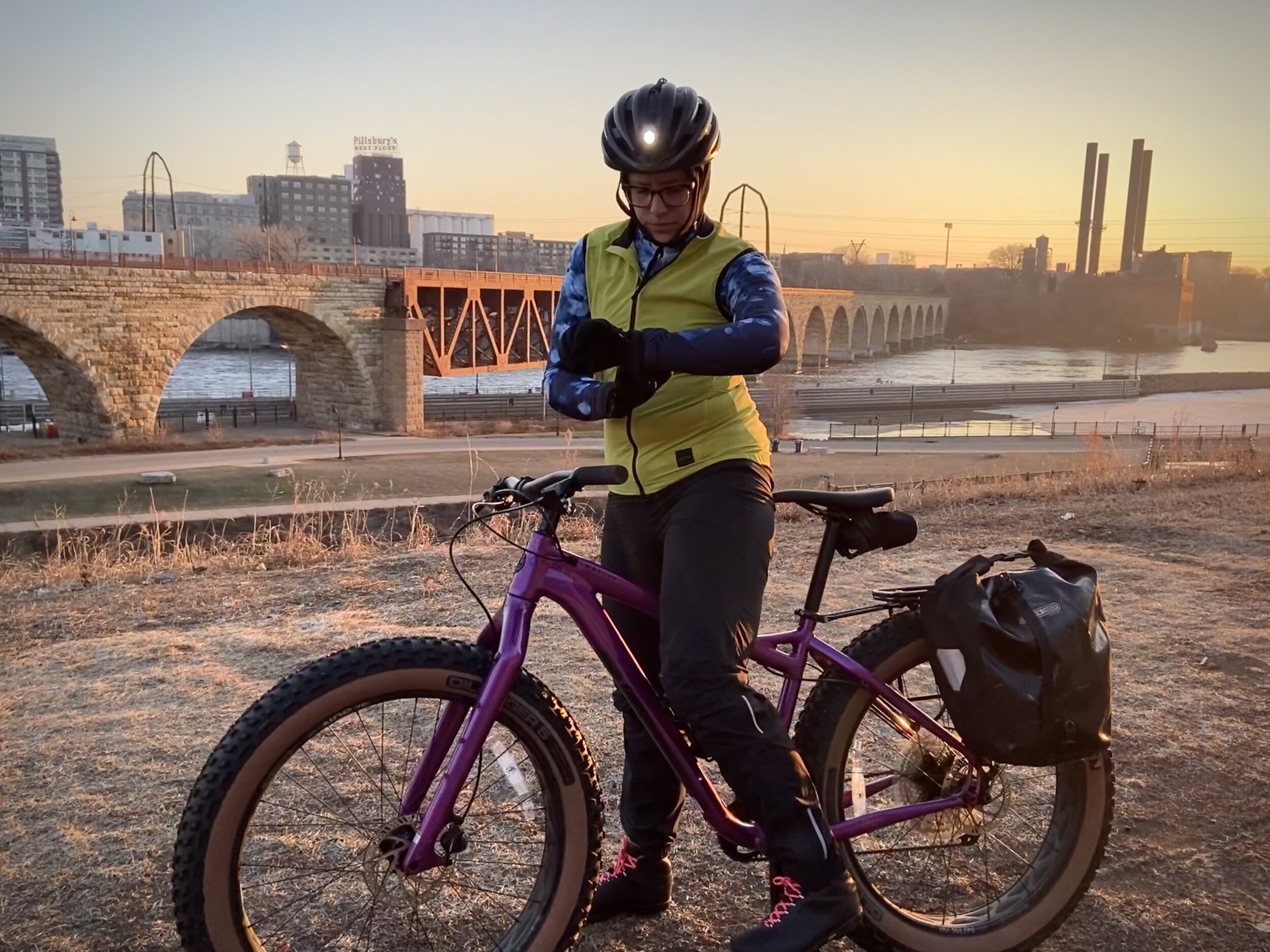And what a day it was. The rain! The mud! The feeling of “I can hardly see, but we’re gonna keep pedaling, damnit!” I crossed the finish line of the 50 mile race more than an hour faster than the year before* and I felt like a million bucks, despite a very wet, very muddy ride. I was already thinking about going back for the 100 in 2023.
Biking Outside the Binary
On what was certain to be one of the last nice days in Minnesota, I was so excited to pick up my bike from my neighbor turned friend turned teammate, Elise. I tossed on some shorts and a windbreaker and, quite literally, ran down the street to her house. After a quick lesson on how to change my pedals (gulp) for clip shoe pedals (double gulp) and loading up my pack with all the stuff she was lending me, I was ready to bike home. It had been weeks since my last ride and, as silly as it was, I was excited to bike the 0.63 miles from Elise’s to my apartment. I missed the feeling of the air against my legs as I zipped down the streets of Minneapolis.
“You must be cold!” exclaimed a man walking across the street. A fair comment, it was 29 degrees and windy. But the sun was out and I had on enough clothes to keep me warm for my six minute ride. Plus, I’m of the Minnesota mentality that shorts are a way of life, not a seasonal wear.
I love my neighborhood. While I’m out walking, running, biking or hanging with my dogs, I take everyone I meet to be a neighbor. And I LOVE sharing a few moments with the people I pass by and never miss an opportunity to chat, even if it’s just for a moment. Especially if it was about my shorts wearing antics. So, tongue in cheek, I responded, “It’s so nice out!”
“Yeah, and you’ve got those sexy legs to keep you warm.”
I started riding my bike again in the spring of 2020. I was tired of my bike staring at me from across the room, where I sat every day during the early pandemic shutdowns. I had never been a serious rider - five mile laps around the lake with my Grandma, biking into town for tennis practice senior year, cruising the “ones” with friends and a boombox duct taped to my handlebars the summer after I graduated high school. A friend helped me put air in the tires (did you know there’s two kinds of air valves?) and I set off for my first ride - 3 miles to meet a friend for ice cream, because I knew I could walk that far if I couldn’t handle the ride.
I never expected to fall in love with my bike, or with riding my bike.
But the joy I felt was insurmountable. The feeling of the air on my face biking down Nicollet Ave as I raced to make it to the library before close. Leisurely making my way to the Mill City Farmer’s Market to meet friends for breakfast and then gliding down to the Washington Ave Trader Joe’s to grab a few groceries for the first time by bike. Taking the long way home around the lakes and onto the Midtown Greenway at dusk. Looking at things I drove past every day with fresh eyes, taking in things I’d never noticed before. I couldn’t keep a smile off my face. Full teeth. Laughing to myself. Why had I ever stopped doing this?
Later that month, George Floyd was murdered 20 blocks from my apartment. Biking became a way to get to protests, biking after curfew became an act of defiance - a way to bite my thumb at the cop cars and tanks I flew past. Biking became an escape after weeks of not sleeping and living off of red bull and cosmic brownies. A temporary reprieve from the state of the city I loved, a way to process the thoughts swirling through my head and the feelings buzzing around in my body. Biking was the way I returned back to myself, to my body, and eventually, to joy.
And as a trans person, joy is an act of defiance. In a world that refuses to understand our experience and refuses to open its minds and hearts, to be committed to joy is radical. The source of my joy is my bike. Dialing into a zoom call where everyone else was in their living rooms or home offices while I was on my bike, making my way home. In biking the Twin Cities Marathon route with a new friend and setting a new distance PR. In biking to meet with friends downtown for a casual hang. In biking to new places or old places or any place really. The rush of pedaling never fades. Biking is a thing I get to do that centers my joy. And to let that level of joy and happiness into my trans body feels healing and revolutionary in a way that I don’t think resonates with my cisgender friends.
“Yeah, and you’ve got those sexy legs to keep you warm.”
11 words. A simple cat call. That’s all it took to remove myself from my body and from my joy. I was no longer Sarah on a bike. I was an object. And what’s worse, someone was maybe perceiving me to be a gender I don’t identify with. This comment, this cat call, let me know that I was not passing despite being on a “men’s” bike, wearing “men’s” shoes, and having on a baggy windbreaker. Not things I had thoughtfully considered when I left my house - I just get dressed - but all things I obsess over when someone misgenders me or perceives my gender.
Which is why my heart breaks for the trans athletes that were subjected to the harassment of an anti-trans hate group during USAC’s Cycling Cyclocross Nationals event December 12th. As an athlete, I know one of the most important things during an event is to be able to keep your mental focus on your sport. As a trans person, I know how impossible that can be after your sense of safety is removed. I cannot imagine what that is like when participating in an elite heat when the organizers of the event sat idly by and allowed this to happen.
You deserve better. We deserve better. Cycling deserves better.
Stamina Racing Collective is determined to be a part of the solution to create a more inclusive sport in which members of marginalized communities feel welcomed and valued and as such, continues to call on USAC to act now to protect ALL it’s athletes. Our requests of USAC have largely been ignored, despite Stamina participating in their inclusion roundtables, offering up resources, and continuing to gracefully call in USAC over the last year.
The future of cycling is uncertain as many of us wait and see what will become of USAC and our own participation (or lack of) in their events for the 2022 season. There is one thing we do know: trans athletes deserve to feel safe when they cycle and we will continue to make that space and help educate others so they feel empowered to as well.
Stamina Takes on The Last Best Ride
Whitefish, Montana is a beautiful place but it is very far away from Minnesota. Watch the video below to see how four Stamina teammates tackled the 20 hour drive to The Last Best Ride, as well as the shenanigans that led up to and followed the race itself!
So many people helped us take on this journey and we are so incredibly grateful!!
Pizza First, Questions Later
“I learned so much, and yet I still learned more about how little I actually know.” Haema summed up Stamina’s Wolf Tooth experience simply and perfectly. On a warm Monday evening seven Stamina riders drove down to Burnsville, MN to visit with three Wolf Tooth employees (one of which was a third of the owner/creator team!) They started the meeting off strong by treating us to pizza and a new flavor of La Croix, and then Chelsea delivered a highly educational presentation on the history of Wolf Tooth, bicycle components in general, and Wolf Tooth products in particular. Dan and Kurt layered on additional history and technical explanations.
Elise and Christina were so excited leaving the event that the following conversation occurred.
Anisa (she/her) with the wolf of Wolf Tooth!
Christina : The most interesting component to me was probably chainrings. Before today, my understanding of chainrings was that the big ring is harder and the little ring is easier. It ends up there is so much more to chainrings than the big ring and the little ring! For example, I didn’t realize that the big ring on my road bike would be any different from the big ring on my gravel bike.
Elise : Right! I appreciated that Chelsea explained the rings to us in a way that made sense. I like how she started with something we understood: chainrings that have more teeth make pedaling harder. Then she explained that road bikes generally stay on roads, which are designed for cars and therefore are generally less steep than mountain bike trails. Therefore mountain bikes and fat bikes tend to have smaller rings than road bikes.
Christina : It was especially cool to learn how many different sizes of chainrings Wolf Tooth has made. I love that they listen to customer needs and are agile enough to make small batches of chainrings. It was fun to hear Dan say that they have made a tiny chainring for someone who was going to fat bike the Iditarod route and they have made a gigantic chainring for someone aiming to break a speed record.
Chelsea introduces us to Wolf Tooth’s handy bolt circle diameter measurement guide. If you print this off on a standard 8.5”x11” piece of paper at 100% scale, you can place your current chainring on the guide to determine which chainring will fit your bike. This looks very useful for ordering the right chainring!
Elise : Beyond the size of the chainring, I also liked learning about the shape of a chainring. I had heard of oval chainrings before, but I hadn’t looked into them or understood why they were oval.
Christina : I liked learning why oval chainrings exist, too. Dan started with something we understood: our legs produce the most downward force when the pedals are horizontal and the least downward force at the top and bottom of the pedal stroke. The oval chainring is widest where the most force is produced and narrowest where the least force is produced, and this capitalizes on the maximal force.
Dan explaining the physics behind oval chainrings.
Elise : On top of that, it was interesting to hear about different oval shapes. If the chainring is too far from circular, then pedaling feels strange. If the chainring is subtly oval, then the pedal stroke can be efficient and still feel natural.
Christina : Chelsea said she put a Wolf Tooth oval chainring on her bike and she adjusted immediately; her pedal stroke still felt comfortable.
Elise : She definitely sold me on that oval or “ellipse” shape, I want to try it out and see what it feels like. Somewhat related to the chain rings but mostly just feedback from the experience, I truly appreciated how welcoming Chelsea, Kurt, and Dan were during our visit. I wasn’t afraid to ask any question, no matter how silly it may have seemed.
Christina : Oh absolutely! They are so customer focused that it was no surprise how willing they were to answer our countless questions. They said you can chat with them through the website or send them an email and real people will respond.
Elise : Exactly, their dedication to customers is out of this world. I thought that the cassette on a bike was made up of different sized chain rings but Dan nicely corrected me and told me that nope, those are called cogs. Knowing that it is a completely different product than the cassette has my head spinning around the fact that they make more than 300 different types of chain rings?!
Christina : It’s bananas.
Elise : Not knowing the difference between a chain ring and a cassette is just one way in which I realize how little I know. Which is why, as someone who likes organized, clean documents, I loved learning about their tech documents! When Chelsea showed us where you can find all their different product resources on their website I almost giggled in excitement.
Christina: I wish more companies would provide documentation like that!
Elise : Same! Knowing that all of that information is available for me and other customers is reassuring so next time I start filling up my digital basket with goodies I actually know what I am getting instead of just guessing.
Christina : The other cool thing about the resources is that they actually explain what they are used for; they don’t simply assume that every single customer knows all the answers.
Elise : Totally. Speaking of filling up our digital baskets, let’s talk about the bar tape. I can NOT wait to add the bar tape to my gravel bike! I like the Supple Lite bar tape because it is super comfortable while still being lightweight. It seems like it would do a great job of cushioning my hands from the bumpy gravel roads on our gravel adventures.
Mariya’s bike sporting Wolf Tooth Supple bar tape and a blue anodized headset spacer.
Christina : Absolutely, and I was shocked to feel how light it was. Even so, I think I’d get the Supple bar tape because I want my hands to feel like they’re holding onto clouds. I hope they start making it in pink!
Elise : Oh yes the fun colors! Who doesn’t love to personalize their bikes? I am leaning towards that brown color for my gravel bike but once my road bike tape goes out I might go for a brighter color to make my dark blue bike really pop.
Christina : Everyone deserves to have the comfiest handlebars possible! We use our hands constantly so why not treat them like the stars they are?
Elise : I 100% agree. Another thing I want to add to my gravel bike is the B-RAD water bottle adapters. Right now, one of my water bottle cages sits a little high on my frame, and so when I ride with my frame bag attached it’s hard to get my water bottle out. The B-RAD system would let me lower the water bottle cage so that I’d have more space to pull out my water bottle without squishing my bag.
Christina : I also like how the B-RAD system allows you to put two side-by-side water bottles where only one water bottle would have fit before. I want to carry all the water bottles! Last week we had to stop at that gas station to buy more water. With the B-RAD system, I could have space for enough water bottles to get me through the Heck of the North (if anything will get me through the Heck of the North!).
Elise : Yeah there are a couple of different products that Chelsea mentioned that really are designed with the rider in mind. The company clearly is so thoughtful in their actions and earnestly believes that any body is a biking body. The solutions that they have come up with for different folks to modify their bikes is inspiring and proof that you can create a perfect bike that fits your body and needs.
Christina : Woof, what a great trip. I’m so happy they were able to meet with us.
Elise : It was an absolute blast and now I need to go dust off my credit card and start putting in some orders!
Stamina Goes West
Madilynn, Elise, Erin, and I (Christina) hit the road to venture to Whitefish, Montana for the Last Best Ride. We had an incredible time and can’t describe the whole trip without writing an epic, so buckle up for this listicle.
From left: Christina (she/her), Madilynn (she/her), Elise (she/her), Erin (she/her)
Going on a bike road trip soon? Here are our top ten tips to make your road trip fun and smooth.
- Pack your cycling gear into a rooftop carrier. Helmets, biking shoes, biking clothes, tools, and other biking gear takes up a lot of space! Packing the bike gear on top of the car means you can save the trunk for snacks (we had like three grocery bags of snacks) and for daypacks with necessities (like your work laptop, a sweatshirt, phone chargers, and a hat).
- Make sure you have a top-of-the-line bike rack, make sure it’s installed properly, and load your bikes as directed. We used Saris’ SuperClamp EX 4-bike, which conveniently fit all of our bikes and had an integrated lock so we could pop into stores. Plus the rack can tilt down so you can still open the hatch and access all the trunk snacks. We loaded the heaviest bikes closest to the car and the lightest bikes on the outside (just as Saris recommends) to minimize the torque on the bike rack. (Why yes, I did get a 5 in AP Physics. Why do you ask?)
Erin, Christina, and Madilynn displaying Saris’ SuperClamp EX 4-bike
- After you load up, triple check that your bikes are secure. Technically this could be grouped into Tip 2, but it’s important enough that we want you to really pay attention. We did this by double checking the bottom straps for each bike, and then compressing the dual hooks to make sure they provided appropriate pressure on each of the tires. The saddest thing would be to glimpse into your rear view mirror and notice your beautiful bike bounce off into the sunset!
All four bikes ready for the long drive home (numbers were not removed because some of us were in denial that it was over).
4. Fill a couple water bottles and freeze them the night before getting in the car. You have to pack those water bottles anyway for your time on the bike, so you might as well make them useful in the car. The frozen water bottles can keep your fresh food cold.
5. Did someone mention fresh food? Oh right, that was me. Absolutely pack fresh food. First of all, your tummy will be displeased if you eat fast food for too many meals. Second, if you’re driving somewhere rural, you may drive for hours without seeing even a fast food joint, and then you’ll be hangry. Third, packing food can be cheaper than buying it on the road. Fourth, eating packed food saves you time on the road (no need for slow restaurant service). Fifth, after a long day of driving, it’s nice to eat real food for dinner. I made a southwest-inspired mix in advance (chipotle chicken, corn, tomatoes, arugula, black beans, cheese, southwest dressing) and packed wraps separately so that we could have a tasty road-side lunch on the first day. Madilynn made empanadas in advance so that we could have an incredible dinner after 12 hours in the car. If you aren’t ready for that level, just pack some sandwiches (with meat or just pbj), snacky veggies (like carrots or celery), and easy fruit (like apples, oranges, bananas).
Elise’s selfie to the crew to confirm that yes, she was awake, and yes she was ready to hit the road.
6. Buy and wear compression socks on long drives. When you’re in tight quarters (such as in a car with 3 teammates on a road trip), you can’t move your legs as easily so circulation in your feet and lower legs isn’t so great. Compression socks apply pressure to your feet and lower legs to prevent blood from pooling in them. After 12 hours in the car, your legs and feet will feel a lot happier. Do compression socks look cool? If you use your imagination. Are they effective? Heck yes.
We made new furry friends every single day.
7. Remember that gas station coffee isn’t necessarily gas station coffee. In other words, you don’t have to drink the coffee that the gas station has stored on a hot plate for the last five hours. Check the fridge area to see if they have canned/bottled coffee. Canned coffee saved the day for us pretty much every day we were on the road.
8. I know I just mentioned coffee, but you also need to drink lots of water. You want to arrive at your destination, pop out of the car, and be ready to hit the trail. To be ready, you need to stay hydrated (and properly fueled). Bring pickles for electrolytes.
Pickle juice is always the answer.
9. Download some music to your phone if you’re heading anywhere rural. Our route through Montana didn’t have internet access so streaming music wasn’t possible for about 10 hours. When I learned that we couldn’t stream music, I generously offered to sing, but Erin rudely turned me down. Don’t worry; nothing can kill my vibe.
After 7 hours on the bike Erin was happy to accept this wiggly pup into her arms.
10. Pack dog treats. You never know.
Protecting Your Brain In Style
“Feeling more connected with my training I could now push myself further. Whether it was a threshold workout to hit specific power levels or recovery rides where I could actually pick terrains that would reflect a relaxing ride outdoors (and not the -15 degree and ice covered road outside my window).”
Becoming Smart With Indoor Training
“Feeling more connected with my training I could now push myself further. Whether it was a threshold workout to hit specific power levels or recovery rides where I could actually pick terrains that would reflect a relaxing ride outdoors (and not the -15 degree and ice covered road outside my window).”
Out in the ice and snow: Reflections on winter riding from year-round commuter
Author: Milo Due, Stamina Racing Collective x Machines For Freedom
Here in the frozen north, we have a saying: there is no bad weather, only bad clothing. That’s something I’ve come to know as a year-round commuter in Minneapolis: any conditions are survivable and even enjoyable if you have the right resources, preparation, and attitude. My first winter commuting, I made more than a few mistakes—it took several seasons to get my ride, my gear, and my mindset dialed in. My first mistake was in not properly maintaining and cleaning my bike. My first winter bike, a single speed steel frame road bike, was very special to me because it was one I had built myself with mostly used and salvaged parts (with extensive teaching and support from a friend who stood over my shoulder the whole time, but still). It had many elements that made it perfect for snowy streets—thin, studded tired that could cut through slush and grip onto ice, and a simple, single speed setup to minimize buildup of grit and grime from Minneapolis’ winter roads. But I underestimated how much salt would get into the works, and by winter’s end, several parts were badly corroded. I’ve learned that winter grime needs to be washed away at least once a week—and though this is somewhat onerous, I’ve found I need to give my bike love so it can love me in return. This year, I began commuting with a fat bike, and have loved feeling extra secure on snow and ice. While you don’t need any kind of specific kind of bike to ride in winter, I love the feeling that my hefty tires can conquer all sorts of riding surfaces and weather conditions. On 4.5 inch tires, I feel unstoppable.
Safety First. The first question I always get about winter riding: is it safe? So many drivers know how road conditions can turn a morning commute deadly. And, my answer is, not really—there are definitely always going to be inherent dangers in heading out into ice and snow—but there are things you can do to make it safer (and, in my opinion, it is considerably safer than driving on winter roads). Several factors are very important safety practices for me when winter comes. One is visibility. Wearing bright orange or yellow as an outer layer helps me stand out against the grey and white winter backdrop, and reflective gear and lights make sure traffic can see me at all times. This is especially important as, in winter, snow and ice crust tends to accumulate into bike lanes, forcing cyclists out into the main lane of traffic (which, in Minneapolis, we are lawfully permitted to occupy, but many drivers seem to not know this or not care). I’ve encountered more than a few drivers who are unhappy about sharing the road with non-motorized traffic (and I’ve been yelled at for being on the road at all in winter—my favorite was a driver who screamed at me trying to get home in a snowstorm, “are you insane??” yes, maybe a little…). My approach has been to fully and unapologetically take the whole lane, which I have found much safer than trying to ride over to the side where there might be more icy debris and where cars may pass with chillingly narrow margins, or may not see me at all. And, with road conditions that are often unpredictable (hello, black ice), I go slow. Though winter riders may be tempted to speed up to keep warm and get out of the cold quicker, the challenging road conditions really require us to slow down, stay alert, and stay predictable in our movements.
My next learning curve was winter gear. My first season riding, I was so scared of being cold on the bike that I layered up in the classic big midwestern parka, scarf, and snow pants, putting on as much clothing as possible to guard against the windchill and snow. Very soon I learned that this was overkill—not only did I overheat and nearly drown in my own sweat by the time I got to work, but many thick layers took away the joy of riding because of how constricted I felt. I needed something that would breathe and allow me freedom of movement, but that would still keep me warm. Now, several seasons in, I have learned that less is more, and I’ve come to appreciate the true beauty of a quality base layer. The best base layers are those that wick away moisture from the skin—so when you’re sprinting because you’re late to work (again)—just me?—and then have to stop at a red light, you don’t freeze. For me, this means merino wool or nylon, any other material just won’t do. The Machines for Freedom Luxe Cropped Base is perfect because it fits nicely under anything and does a great job at wicking moisture. In the darkest days of deep winter, I’ll add a medium-weight wool middle layer, but for most days that cannot be classified as “polar vortex”, just a base layer and an outer shell usually does the trick. I have for years used a raincoat and rain pants, and have recently upgraded to the Machines for Freedom All Weather jacket for its ability to stop wind, protect me from the elements, keep me warm, and vent excess heat. A merino wool balaclava also helps to keep my face, head, and neck warm while being lighter weight underneath a helmet, and in extreme temps I’ll throw on goggles to guard against frostbite. Finally, the trickiest part of winter gear is hands and feet—parts that tend to catch all the wind when riding and are hardest to keep warm. Thin wool socks and a good pair of waterproof winter boots (sized up to allow for a layer of air for my body heat to warm) are lifesavers, and I’ll sometimes throw in toe warmers on colder mornings. Some winter riders opt for pogies—mittens that fit over your handlebars and allow for greater dexterity and wind blocking—but I’ve loved my lobster claw mittens that keep my digits warm together while allowing me to shift and break.
The mindset. As many cyclists know, the most challenging aspect of riding can often be the mental or emotional component. Though I am a native Minnesotan, I’ve long been a person who has dreaded winter, with its bleak, dead landscapes, harsh wind and temperatures, and wet snow. I’ve braced against the changing of the seasons, cursed the waning light, and wished for summer while trying to keep warm and dry inside. Riding year-round has totally changed my outlook on winter. Getting outside in the fresh air daily (however much it may sting the lungs at first) has made me appreciate how the landscape changes with the seasons, and notice moments of desolate winter beauty: spotting eagles through the bare trees, stopping to watch a frosty sunrise over the Mississippi, feeling like I have the city all to myself. Most importantly, I’ve learned to trust in my own toughness, resilience, and ability to withstand the elements, and I’ve learned to trust my body as the engine that gets me from place to place. On my bike, I’m not beholden to gas prices, stop-and-go traffic, bus schedules, or parking restrictions—and I can revel in the satisfaction of getting where I need to go each day by my own steam.
My advice for anyone in a cold climate considering becoming a year-round cyclist is this: take winter and its challenges seriously, but believe in your capability to acclimate and to meet those challenges. You don’t need all the fanciest gear or the latest fat bike, but you do need to put some thought into your clothing (frostbite is real!) and experiment with what works for you. And, find community! Minneapolis has a great community of year-round riders who are more than willing to share their wisdom and tricks. For instance, Grease Rag, a Minneapolis collective centering FTW (femme, trans, and women) cyclists, hosts a gear swap and skill-share every year so more people can access this knowledge and otherwise costly winter gear. The more I have made it a regular practice to commute by bike every day, the more I can take the discomforts of winter in stride, and see the beauty in the ice and snow (and slush and grime).
Stamina Racing Collective x Machines for Freedom Stands with Trans Athletes
In fall 2018 and again in fall 2019, Veronica Ivy defended her first place title at the masters track cycling world championship event for 35-39 year old women. Following her victory, a wave of comments flooded social media regarding an alleged unfair advantage between trans women and cisgender women in cycling. Today, The House passed The Equality Act, which will amend civil rights to extend non-discrimination protections to LGBTQ Americans, including transgender Americans. The Equality Act comes at a crucial time, as several states have been actively working to ban transgender athletes from participation in sport (1) .
Though some people have approached the issue with curiosity and a desire for more knowledge, others have resorted to name calling, harassment, and dehumanizing language regarding trans athletes in sport. Some have stated they don’t agree with the inclusion of trans or non-binary athletes in cycling due to supposed biological advantages. We are writing to express our continued support for transgender and non-binary athletes in cycling and to request that the cycling community provides the same level of clear and steadfast support for transgender athletes.
The field of cycling and the inclusion of transgender athletes has progressed over the years, particularly since the 2015 revisions to the the CAS policy regarding transgender and intersex athletes. We are concerned that the current sociopolitical climate, misinformation, and misconceptions will allow opponents to reverse this progress.
We agree with the United Nations’ stance that sport is a human right (2), and thus write to reiterate that trans women have a human right to compete in the women’s field. We recognize that the IOC principles, Court of Arbitration for Sport, USA Cycling (3), and NCAA decisions are informed by scientific, legal, and ethical principles in sport, and thus, we support their decisions to include trans women in women’s fields.
What Does the Research Say?
The science and research in this area is limited. Though research in this area is difficult to do and find, one 2017 systematic review of 8 research articles and 31 sport policies concluded that “there is no direct or consistent research suggesting transgender female individuals (or male individuals) have an athletic advantage at any stage of their transition.”(4) It is unethical and unfair to rest on the argument that trans women have inherent biological advantages over cisgender women in sport without having peer reviewed empirical research to support these arguments or policies. Moreover, the prohibition of trans women from women’s competition constitutes discriminatory behavior that works directly against USA Cycling policies and values.
Research also clearly demonstrates that trans athletes face several negative effects that stem from the transphobic beliefs and discriminatory actions of others. For example, a lack of an inclusive environment serves as a major constraint to participation for trans athletes (4). In one recent study of women and gender diverse cyclists, 31 trans and nonbinary participants responded to a list of 50 potential constraints to participation in cycling (5). The highest rated factor that decreased their participation in cycling was “Lack of equitable opportunities for gender diverse cyclists.” Other highly rated constraints to participation included “Feeling as though I don’t belong” and “Inaccurate assumptions about women and gender diverse cyclists.” In comparison to cisgender women, trans women reported a significantly higher frequency of being made fun of, picked on, pushed, shoved, hit, or threatened with harm, t(98) = 2.338, p = .021. Trans and non-binary cyclists who participated in this study reported various forms of harassment in sport, including verbal assaults, threats, whispers, purposely being misgendered, being stared at or pointed at, and being generally excluded from one’s community (6). One racer shared her experiences of being spit on and having her equipment sabotaged. Another participant stated, “I felt like I didn’t and couldn’t feel safe in any cycling community and maybe it was best if I stopped cycling.”
Transgender and non-binary people already face discrimination, rejection, and a lack of access to resources both in and outside of sport (7). Suicidality is significantly higher in transgender adults than the general population due to the risk factors associated with being trans (7). We urge our community members to actively welcome and include trans and non-binary athletes in cycling.
Conclusion
To increase the participation of all women in cycling, it is imperative that those in the community work together to make cycling a more inclusive sport. As such, it is essential to support trans women in cycling. We, Stamina Racing Collective, welcome trans women in women’s fields and recognize their value in our sport. We urge others to do the same.
References
Reimer, A. (2021). Transgender athlete bans are gaining momentum in state legislatures. Forbes Magazine.
United Nations. (2007). Women 2000 and Beyond: Women, Gender Equality, and Sport. New York: Division for the Advancement of Women, Department of Economic and Social Affairs. United Nations.
USA Cycling. (2018). Transgender athlete participation.
Jones, B. A., Arcelus, J., Bouman, W. P., & Haycraft, E. (2017). Sport and transgender people: A systematic review of the literature relating to sport participation and competitive sport policies. Sports Medicine, 47, 701-716.
Ayala, E. E., Waniger, K. J., Faulkner, K. P. A., & Riley-Schmida, A. (2020). Experiences that Affect Participation for Women and Gender Diverse Athletes in Competitive Cycling. Journal of Outdoor Recreation, Education and Leadership, 12, 10-26. Doi: 10.18666/JOREL-2020-V12-I1-9912
Ayala, E. E., Riley-Schmida, A., Faulkner, K. P. A., & Maleski, K. J. (in press). Microaggressions experienced by women and gender diverse athletes in competitive cycling. Women in Sport and Physical Activity Journal.
Herman, J. L., Brown, T. N. T., & Haas, A. P. (2019). Suicide thoughts and attempts among transgender adults: Findings from the 2015 U.S. Transgender Survey.
Additional Resources
Empirical Research Articles
Ayala, E. E., Riley-Schmida, A., Faulkner, K. P. A., & Maleski, K. J. (in press). Microaggressions experienced by women and gender diverse athletes in competitive cycling. Women in Sport and Physical Activity Journal.
In this article, the authors define and describe microaggressions in the context of cycling. They explain the types of microaggressions and forms of harassment that women experience, including trans women and non-binary racers. Please mail staminaracing@gmail.com for a copy of this article.
Ayala, E. E., Waniger, K. J., Faulkner, K. P. A., & Riley-Schmida, A. (2020). Experiences that affect participation for women and gender diverse athletes in competitive cycling. Journal of Outdoor Recreation, Education and Leadership, 12, 10-26. doi: 10.18666/JOREL-2020-V12-I1-9912
This article identifies factors that increase and decrease participation of women, trans, and non-binary athletes in competitive cycling. Athletes attributed a lack of presence or support and unsafe environments to their decreased participation in cycling. They described feelings of isolation and acts of exclusion, a general lack of value or consideration for gender diverse athletes, and being singled out as gender diverse athletes.
Gleaves, J., & Lehrbach, T. (2016) Beyond fairness: the ethics of inclusion for transgender and intersex athletes. Journal of the Philosophy of Sport, 43(2), 311-326, doi: 10.1080/00948705.2016.1157485
“This article contends that arguments for narrativity rather than physiological equivalency show that exclusion is not only misguided but also undesirable: it is detrimental not only to the excluded athletes but to sport itself. The article yields several important consequences including calls for revisions to policies on transgender and intersex athletes.”
Handelsman, D. J. (2018). Circulating Testosterone as the Hormonal Basis of Sex Differences in Athletic Performance, Endocrine Reviews, 39(5), 821-823.
“There is a wide sex difference in circulating testosterone concentrations and a reproducible dose-response relationship between circulating testosterone and muscle mass and strength as well as circulating hemoglobin in both men and women. These dichotomies largely account for the sex differences in muscle mass and strength and circulating hemoglobin levels that result in at least an 8% to 12% ergogenic advantage in men. Suppression of elevated circulating testosterone of hyperandrogenic athletes results in negative effects on performance, which are reversed when suppression ceases.”
Ingram, B. J., & Thomas, C. L. (2019). Transgender policy in sport, a review of current policy and commentary on the challenges of policy creation. Current Sports Medicine Reports, 18(6), 239-247. doi: 10.1249/JSR.0000000000000605
The authors summarize the history of sex policies in sport and discuss the difficulties associated with such policies. They conclude that scientific evidence is limited regarding fairness for transgender athletes and note that medical and scientific community members will continue to do scholarly work in this area.
Ivy, V. (in press). If Ifs and Buts were Candy and Nuts: The failure of arguments against trans and intersex women’s full and equal inclusion in women’s sport. Feminist Philosophy Quarterly.
The author of this article responds to several common arguments against the inclusion of trans athletes in sport. Dr. Ivy challenges the notion of transgender women being “biological men,” disputes the argument that trans athletes are dominating women’s sports, and reviews evidence regarding alleged unfair advantages of trans athletes in sports.
Jones, B. A., Arcelus, J., Bouman, W. P., & Haycraft, E. (2017). Sport and transgender people: A systematic review of the literature relating to sport participation and competitive sport policies. Sports Medicine, 47, 701-716.
“In relation to sport-related physical activity, this review found the lack of inclusive and comfortable environments to be the primary barrier to participation for transgender people. This review also found transgender people had a mostly negative experience in competitive sports because of the restrictions the sport's policy placed on them. The majority of transgender competitive sport policies that were reviewed were not evidence based.”
McKinnon, R., & Conrad, A. (2018). Including trans women athletes in competitive sport: Analyzing the science, law, and principles and policies of fairness in competition. Philosophical Topics, 46, 1-68.
“In this paper, we examine the scientific, legal, and ethical foundations for inclusion of transgender women athletes in competitive sport, drawing on IOC principles and relevant Court of Arbitration for Sport decisions. We argue that the inclusion of trans athletes in competition commensurate with their legal gender is the most consistent position with these principles of fair and equitable sport. Biological restrictions, such as endogenous testosterone limits, are not consistent with IOC and CAS principles...Thus, in place of a limit on endogenous testosterone for women (whether cisgender, transgender, or intersex), we argue that ‘legally recognized gender’ is most fully in line with IOC and CAS principles.”
United Nations. (2007). Women 2000 and Beyond: Women, Gender Equality, and Sport. New York: Division for the Advancement of Women, Department of Economic and Social Affairs. United Nations.
Legal Briefs
This legal brief argues that there is a longstanding precedent regarding the importance of equality under law. It also notes the experiences of coaches, teammates, and other allies of trans athletes demonstrate that the participation of trans women in sport benefits all athletes (including cisgender women).
“All amici interviewed reported positive experiences with trans women athletes—and found competition with these athletes to be not only fair but welcomed…As multiple amici explained, trans women pose no threat to fair competition, including because, as amici’s experiences demonstrate, success in sports is determined by a multitude of factors (such as natural talent and the amount of effort dedicated to learning and practicing a sport). Transgender status is simply inconsequential to competitive outcomes. Many amici also share that they have grown personally as a result of their experiences with trans women in their sport. Several note that the inclusion of trans individuals on a team fosters a sense of community; teammates learn about different experiences and perspectives and often ultimately support the inclusion of all players, regardless of their backgrounds, to enjoy something they have in common—the sport. Multiple amici also observe that working with trans athletes enabled them to overcome their own biases and fostered an ability to treat all players (and all people) equally. Ultimately, amici’s experiences demonstrate that trans women are just like other women—and should be afforded the same opportunities to participate in women’s sports.”
National Women's Law Center Amicus Brief in Support of Trans Athletes
The National Women’s Law Center explains why transgender bans harm trans girls, cisgender women and girls who do not conform to stereotypes, and disproportionately targets girls and women of color. This brief also explains why trans bans are a violation of Title IX.
Former Idaho Attorneys General Amicus Brief in support of Trans Athletes
In this legal brief, former attorneys explain why proposed trans bans on athletes violate the Equal Protect Clause, are unconstitutional, and create harm
Interact Amicus Brief in support of intersex athletes
This brief argues that sex verification inflicts severe trauma on students, especially intersex students. It also argues that there is no justification for discriminatory treatment of intersex student athletes.
Hecox v Little - Safer Declaration
This legal document offers an expert opinion on the medical and scientific concepts relevant to the attempted regulation of transgender girls and women playing sports and the related policies.
Transgender Athletes Amicus Brief
In this report, transgender athletes explain they do not dominate their sports as a result of their gender. They note how their involvement in sport allows them to overcome difficulties associated with gender dysphoria, negative self-image, and a lack of self-confidence. This report also notes the “faulty science and erroneous assumptions” about transgender people. Finally, the report notes that discriminatory policies such as bans on transgender athletes cause serious harm to trans athletes while providing no benefit to cisgender athletes.
In this report, 13 healthcare organizations explain what it means to experience gender dysphoria, including its seriousness and accepted treatment protocols. They then explain why and how the exclusion of trans girls and women from sports negatively affects their health, safety, and well-being.
Articles and resources for those who want to learn more
What is the T in LGBT? Supporting Transgender Athletes Through Sport Psychology
This article from 2011 was written with Sports Psychologists in mind but can be applied to all individuals looking to learn more about the transgender experience. It breaks down common myths regarding transgender athletes along with suggestions about how to support all athletes.
Myths and Facts about Trans Athletes, Debunked (Author: ACLU)
The ACLU demystifies several common misconceptions about rans athletes in sport. The conclude the following:
Including trans athletes will benefit everyone
Trans athletes do not have an unfair advantage in sports
Trans girls are girls
Trans people belong on the same teams as other students
